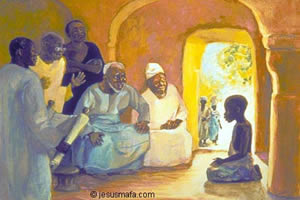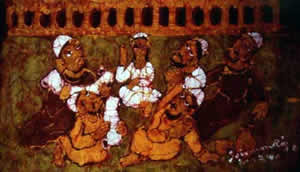"Plunge Yourself Into Obscurity:"
The Hidden Years of the Boy Jesus
For Sunday December 27, 2009
Lectionary Readings (Revised Common Lectionary, Year C)
1 Samuel 2:18–20, 26
Psalm 148
Colossians 3:12–17
Luke 2:41–52
Scattered throughout our house are a number of baby pictures of our three children. Is that what they really looked like twenty years ago? Having just considered the baby Jesus of Christmas, it’s fascinating to ask a question that we really can't answer: what did Jesus look like? The earliest frescoes from the third and fourth century, for example, picture Jesus with short hair and clean-shaven; only later images portray him with a beard and long hair.
If you are white, American, and Protestant, your images of Jesus were probably influenced by one of the most reproduced pictures ever, The Head of Christ (1940) by Warner Sallman. One scholar estimates that Sallman's saccharine image of Jesus with blondish hair, blue eyes and fair skin has been reproduced over 500 million times. You can find this reproduction not only in America but in churches around the world. Sallman’s painting is a reminder of the chronic temptation to create Jesus in our own image, according to our own time, place and culture. |
The Boy Jesus in the Temple by He Qi (China) |
But Jesus is far more elusive than we might wish. We not only don’t know what he looked like. One of the curious features about the Christian story is that we don't know anything about Jesus before he began his public ministry around the age of thirty. It's only an inference that he followed his father Joseph as a carpenter. Scholars speculate whether he went to school. He left not a single scrap of writing. The Gospels of Mark and John don't even include birth narratives, but begin with Jesus as an adult.
Still, it's hard not to speculate, especially when you consider that Mary assuredly told stories about her son. In the centuries after Jesus, a genre of "infancy narratives" emerged to embellish the "missing" or "hidden" years of Jesus with fanciful legends. In the Infancy Gospel of Matthew animals speak at Jesus's nativity. In the Infancy Gospel of Thomas (c. 140–170), which Anne Rice utilized in her fictional Christ the Lord (2005), Jesus curses a playground bully who consequently dies, then raises him to life with a spontaneous wish-prayer. He turns clay pots into flying birds. In the Arabic Infancy Gospel (sixth century?) Jesus's diaper heals people, and his sweat cures leprosy. Other fables claim that when Jesus was twelve he sailed to England with Joseph of Arimathea and built a church near Glastonbury to honor his mother Mary, or that between the ages of twelve to thirty he studied in India, Persia, or Tibet.
Most of the early church rejected these fables about Jesus as spurious. Instead, they followed the lead of the gospel writers by contenting itself with ignorance and silence about Jesus's early years. Their reticence and restraint about the hidden years of Jesus are remarkable, and reminders that the early believers were not gullible or naive when it came to sensationalist exaggerations about miracle stories.
We do, however, have once brief exception to our otherwise total ignorance about the first thirty years of Jesus's life. Luke's Gospel for this week records the only canonical story we have about the years between Jesus's birth and his public ministry, and it is much more prosaic than we might wish. It is the story of the twelve-year-old Jesus in the Jerusalem temple.
 |
Jesus Among the Teachers, Jesus Mafa |
Luke writes that every year Joseph and Mary made the 150-mile roundtrip from Nazareth to Jerusalem in order to celebrate the Feast of Passover. When he was twelve years old, about twenty miles into the return trip home to Nazareth his parents discovered that Jesus was missing from their caravan of family and friends. Any parent can imagine the terror that they must have felt when they couldn't find their son. After a second day to return to Jerusalem, on the third day they found the boy Jesus in the temple, "sitting among the teachers, listening to them and asking them questions." When Mary rebuked him it became apparent that Jesus was not accidentally lost, but that he had deliberately stayed behind: "Didn't you know that I had to be in my Father's house?" Mary and Joseph didn't understand this mysterious response. After their safe return to Nazareth Jesus "was obedient to them. . . [He] grew in wisdom and stature, and in favor with God and man" (cf. 2:40 and 1 Samuel 2:26).
Two points in Luke's story deserve mention. He reminds us that Jesus was a normal boy who experienced genuine human development—physically, mentally, morally, and spiritually. Jesus's authentic humanity is precisely what the legendary "infancy narratives" obscure and deny. The story also hints at the emerging tension between Jesus's filial identity with God the Father and his willing obedience to his earthly parents. Eventually his obedience gave way to a radical disruption, for by the time of his public ministry his own family tried to apprehend him and the entire village of Nazareth tried to kill him as a deranged crackpot (cf. Mark 3:21, Luke 4:29, John 7:5).
But that's all. These two points do nothing to fill in the thirty years of silence about the hidden years of Jesus. I like to imagine that Jesus's early life was so insignificant, so prosaic, and so secluded in obscure Nazareth that there was nothing relevant to report.
If we let Jesus's silent years stand at face value instead of filling them with some ostensibly deep meaning, they speak volumes in our media-saturated world of celebrity culture, self-promotion, and endless noise. His hidden years point to a counter-cultural spirituality of invisibility and obscurity.
For most people today, and Christians are by no means an exception, personal identity and fulfillment depend upon being well-known not unknown, visible and not invisible, honored rather than ignored, important instead of insignificant, and in demand rather than out of commission. But when I consider how thoroughly invisible Jesus was for 90% of his life, leaving no footprint of who he was or what he did during those years, I'm attracted to a spirituality of obscurity, seclusion, and hiddenness.
Most of us live hidden and unheralded lives. We live, die, and then will be forgotten to history. We will be lucky if even our grandchildren remember us. My friend Betsy is a stay-at-home mom who left a career as an attorney in order to cook, clean, do laundry, and chauffeur five kids to the dentist, school, birthday parties and sporting events. Her husband enjoys a prestigious career. Claudette raised a family but now lives alone in a tiny apartment as an elderly widow. Dan was a high-flying business executive who's been unemployed for two years after the economy cratered.
 |
Jesus in the Temple, by Solomon Raj (India). |
Some believers have chosen hiddenness. The fourth-century monastics fled the corruptions of crowded cities to seek Jesus in the vast solitude of the Egyptian desert. The Trappist monk Thomas Merton (1915–1968) spent twenty-seven years cloistered in Gethsemane Monastery in Kentucky, but nevertheless spoke to the entire world with his prophetic writings. In his memoir The Road to Daybreak, Henri Nouwen (1932–1996) describes why he left his professorship at Harvard to live and pray among the developmentally-disabled. When I visited Liberia in 2006 I was reminded how entire countries remain invisible to the world because they are so insignificant to the geo-political calculus of the day.
For Christians, the delicious paradox is that the missing 90% of Jesus's life, no matter how completely lost to history, was not lost or hidden to God, not by a long shot. Nor is my life or your life. Liberia, Congo, and Darfur are not hidden to God, even though the world ignores them. After raising six kids and then experiencing a divorce, my mother lived by herself for thirty-three years, but none of those years were lost to God.
With Hagar the slave who was was banished to the desert, we can name Yahweh "the God who sees me." Her child bore a special name, Ishmael, which in Hebrew means "God hears" (Genesis 16:1–6). God sees and hears, He loves and cares. He doesn't ask us to lament or transcend our invisibility to the world. He might even disrupt our lives by inviting us to try it. The apostle Paul writes that our true life is "hidden with Christ in God" (Colossians 3:3). He described himself as "known, yet regarded as unknown" (2 Corinthians 6:9). In the Beatitudes Jesus calls us to give, to pray and to fast "in secret" (Matthew 6:4, 6, 18). The unseen Father, says Jesus, "sees what is done" in secret.
However hidden and obscure our lives might feel, either literally or figuratively, whether voluntary or involuntary, in that very hiddenness God is redemptively present, just as He was with a twelve year old Jewish boy in an obscure Palestinian village.
For further reflection
Boris Pasternak (1890–1960)
To Be Famous
Creation calls for self-surrender,
Not loud noise and cheap success.
Life must be lived without false face,
Lived so that in the final count
We draw unto ourselves love from space.
So plunge yourself into obscurity
And conceal there your tracks.
But be alive, alive your full share,
Alive until the end.
Wendell Berry (born 1934)
Manifesto: The Mad Farmer Liberation Front (last two stanzas)
As soon as the generals and the politicos
can predict the motions of your mind,
lose it. Leave it as a sign
to mark the false trail, the way
you didn't go.
Be like the fox
who makes more tracks than necessary,
some in the wrong direction.
Practice resurrection.
Image credits: (1) www.heqiarts.com; (2) Vie de Jesus Mafa; and (3) Asian Christian Art Association.





